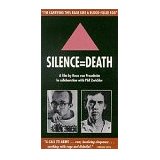Silence = Death
| Silence = Death | |
|---|---|
 | |
| Directed by | Rosa von Praunheim |
| Screenplay by | Rosa von Praunheim |
| Produced by | Rosa von Praunheim Michael Lupetin |
| Starring | Bern Boyle Emilio Cubeiro Rafael Gamba Allen Ginsberg Keith Haring Paul Smith David Wojnarowicz |
| Cinematography | Mike Kuchar |
| Edited by | Rosa von Praunheim Mike Shephard |
Production company | Rosa Von Praunheim Filmproduktion |
| Distributed by | First Run Features. |
Release date | 4 May 1990 |
Running time | 60 minutes |
| Countries | United States West Germany |
| Language | English |
Silence = Death is a 1990 documentary film directed, written, and produced by Rosa von Praunheim.[1] The film centers on the responses of New York City artists to the AIDS epidemic. Those interviewed include East Village artist David Wojnarowicz, poet Allen Ginsberg, graffiti artist Keith Haring, Peter Kunz, Bern Boyle, and many others. It is the first installment of von Praunheim and 's trilogy about AIDS and activism, later followed by Positive (the third part, about the AIDS epidemic in Germany, was never released in the United States).[2] The film was awarded the Queer-Film-Prize of the Berlinale.[3]
Plot[]
This film explores the reactions and response of New York City's artistic community to the ravages of the AIDS epidemic and other issues of homosexuality. Activists interviewed were representatives from the many arts organizations that had alerted the public to the crisis through performance art, music, theater and literature. Even with the gentler voices, the film's undercurrent is an angry demand for action and recognition.
Artist David Wojnarowicz appears shaking with anger as he confronts the diseased society that has turned its back on him and all other AIDS victims. He reads several angry tirades and provides experimental film material and paintings. Painter provides a vengeful indictment of homophobic bigotry.
Another segment includes Keith Haring. He is seen working on a complicated erotic mural, commenting that the painting is "about nostalgia. It's not about anything that could happen now". Haring shares his nostalgic longing for the days of carefree sex. He died from AIDS-related complications on February 16, 1990, three months before the movie was released on May 4, which would have been his 32nd birthday.
Allen Ginsberg's segment muses on sexual experimentation and attitudes, and declares that the planet itself has AIDS.
References[]
- ^ Maslin, Janet (May 4, 1990). "Review/Film; Of AIDS, Frustration And Fury". The New York Times. ISSN 0362-4331. Retrieved 2021-04-24.
- ^ Murray, Raymond. Images in the Dark: An Encyclopedia of Gay and Lesbian Film and Video. TLA Publications, 1994, ISBN 1880707012. p. 109
- ^ "Berlin International Film Festival (1990)".
External links[]
- English-language films
- 1990 films
- 1990 documentary films
- American documentary films
- American films
- American LGBT-related films
- German documentary films
- West German films
- German LGBT-related films
- Documentary films about HIV/AIDS
- Documentary films about New York City
- LGBT history in New York City
- Films directed by Rosa von Praunheim
- 1990 LGBT-related films